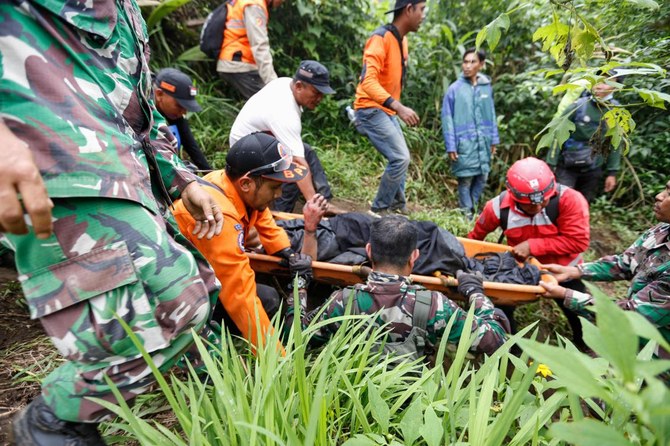AGAM, Indonesia: The number of hikers found dead after a volcano eruption in Indonesia has risen to 22 after nine more bodies were found, a local search and rescue agency official said Tuesday.
“9 of 10 missing victims were found dead this afternoon and at the moment, they are being evacuated. There is one remaining victim currently in search,” Abdul Malik, head of Padang Search and Rescue Agency said.
Thirteen dead hikers were found Monday near the crater of Mount Marapi on the island of Sumatra, with rescue officials announcing 11 deaths the same day and two more on Tuesday.
Others were found alive and carried down the mountain in arduous rescue efforts hampered by further eruptions and bad weather.
The volcano spewed an ash tower 3,000 meters — taller than the volcano itself — into the sky on Sunday.
“The total number of people who have died is currently 13 people. The 10 missing hikers are still being searched,” Abdul Malik, head of Padang Search and Rescue Agency said, adding the bodies of the two additional dead hikers were found late Monday.
Five of the dead had been brought down the mountain for identification while eight bodies had been found and were being brought down in bodybags, he said.
Images shared by national search and rescue agency Basarnas showed a rescue team of six in orange jackets and hard hats carrying a body down the side of the volcano.
The volcano was still erupting on Tuesday morning, according to officials, hampering the rescue efforts of more than 200 personnel.
Rescuers were attempting manual evacuations, walking to the top of the volcano and evacuating the victims on stretchers because of ongoing eruptions and poor visibility, said Hendri, a local rescue official who like many Indonesians goes by one name.
Ahmad Rifandi, head of Marapi’s monitoring post, said Tuesday it had observed five eruptions from midnight to 8 a.m. local time (0100 GMT).
“Marapi is still very much active. We can’t see the height of the column because it’s covered by the cloud,” he said.
Volcanic ash was still falling around an information post at the base of the mountain where Marapi was not visible, according to an AFP journalist.
The head of Indonesia’s volcanology agency, Hendra Gunawan, said Marapi has been at the second level of a four-tier alert system since 2011, and a three-kilometer exclusion zone had been imposed around its crater.
He appeared to blame hikers on Monday for going too close to the crater, saying the agency recommended no human activities in that zone, and emphasized that “severe impacts” were reported for victims within one to 1.5 kilometers from the crater.
Officials said the hikers had registered through an online booking system, but others may have been on illegal mountain routes.
Relatives were still waiting for updates at the information center at the base of the mountain.
“I will stay here until I hear some news,” said Dasman, father of missing hiker Zakir Habibi, who made a two-hour drive from Padang city to the base of the mountain in hope of good news.
“I still hope my son survives,” he said on Monday.
A total of 75 hikers were listed by officials as hiking on the mountain since Saturday, with some of the 49 initially accounted for suffering burns and fractures.
The search will carry on for seven days, rescue officials said.
Those killed were severely burned and forensic workers were preparing to identify the dead by dental and fingerprint records, or based on marks on their bodies, said Eka Purnamasari, an official from the West Sumatra police medical unit.
Locals described the carnage when the volcano burst to life on Sunday.
“The villagers were shocked because of the thundering noise, then there was a jolt and also a boom. The villagers were very traumatized by the eruption,” said Adrizal, head of local village Nagari Lasi.
Mount Marapi, which means “Mountain of Fire,” is the most active volcano on Sumatra island.
Indonesia experiences frequent seismic and volcanic activity due to its position on the Pacific “Ring of Fire,” where tectonic plates collide.
The archipelago nation has nearly 130 active volcanoes.




























